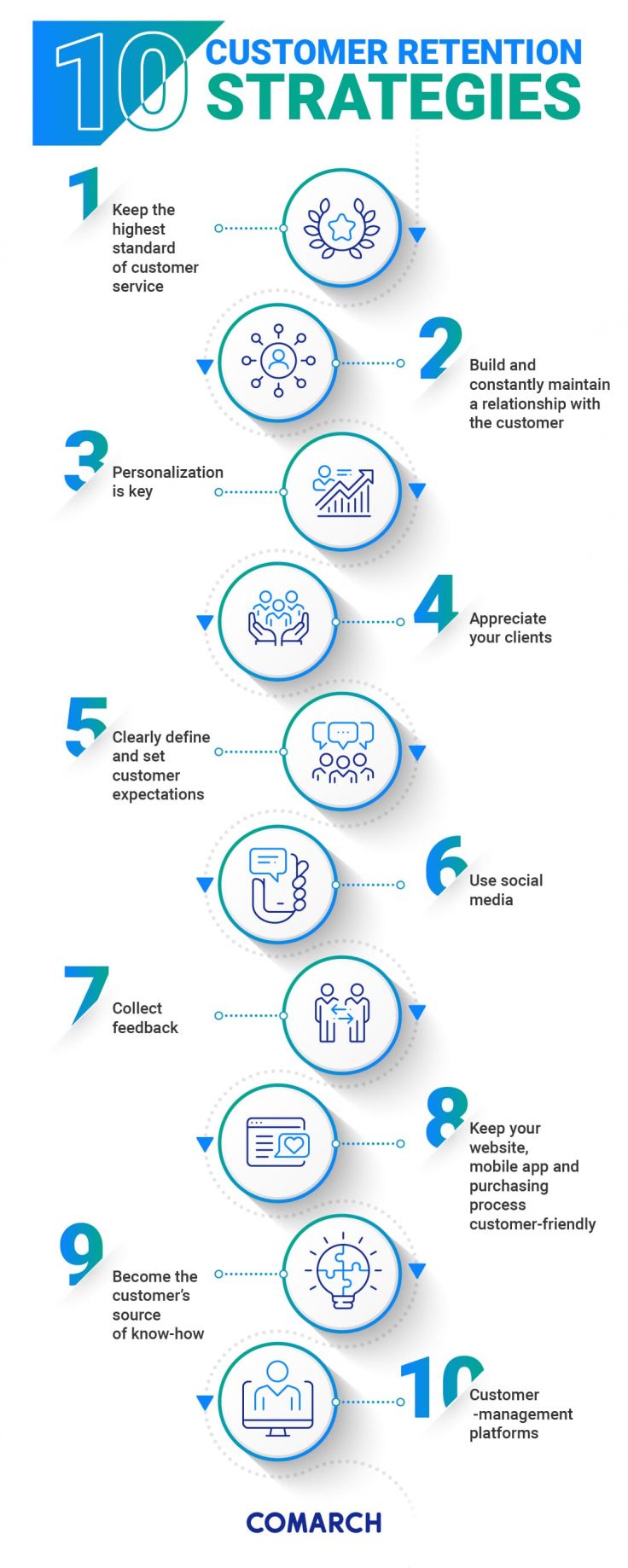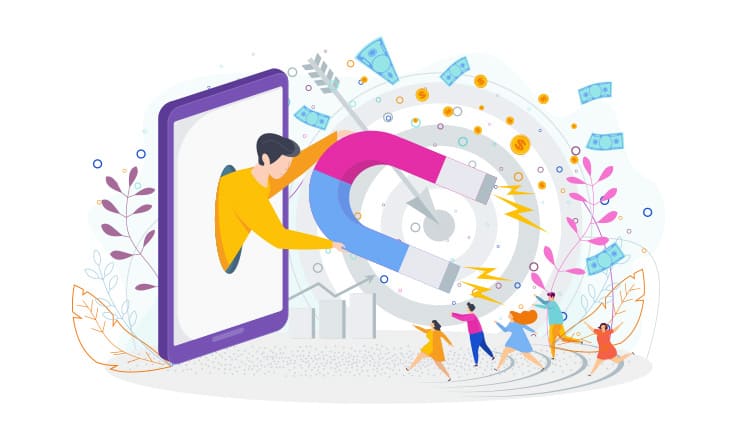10 Customer Retention Strategies for 2022 that Actually Work
- Published
- 12 min reading

Clients not coming back? Here are 10 Customer Retention Strategies that can help you reignite their interest in your brand.
It goes without saying that the success of your company depends on your clients. However, it may be that you focus too much on trying to reach new customers. But what about the existing ones? Do you care about what they do, how they shop, what they think of your brand? If not, then you should definitely learn more about the latest customer retention strategies and start using them ASAP.
Read this article to learn:
- What customer retention is
- About the difference between retention and loyalty
- How customer retention management can lead to more loyalty
- What benefits you can gain by nurturing your existing customer relationships
- About TOP 10 customer retention strategies for 2022
Okay, so What is Customer Retention?
Long story short, customer retention is about how good a given company is at managing its customer relationships. It shows its ability to engage clients over specific periods of time and influence their shopping behavior so that they come back to its brick-and-mortar and online stores more often in order to buy more products (or services). In other words, it is what the company does to stop customer turnover (the percentage of customer base lost over a given period of time).
Believe it or not, not only is retaining customers less expensive than acquiring new ones, but it also generates more profits.
According to the research done by Bain&Company, a 5% increase in customer retention rates can produce from 25% to 95% revenue growth.
So, as you can see, it is a game worth playing. That’s why in this article we will present 10 customer retention techniques that will help you keep your clients close and boost your customer retention rates. But first…
Retention vs Loyalty: What’s the Difference?
Customer retention and customer loyalty – two terms that most of today’s marketers use thinking they are synonyms when, in fact, each of them means something different. We already know the definition of customer retention is – the ability to retain a customer for a specified period of time, presented in a number/percentage of customers who are still active.
As for customer loyalty, it is about measuring and monitoring how often a particular customer buys and uses the products and services offered by your company.
The similarity and dependency between those two terms is easily noticeable, as it is not possible to create customer loyalty without an effective retention strategy. Acquiring and maintaining comprehensive customer data facilitates predictive analytics, which make it possible to identify trends in customer behavior, reduce churn effectively, and – ultimately – run a successful loyalty program.

Here's Why You Should Take Good Care of Your Existing Customers
Here’s the formula a lot of today’s companies follow – 1. get a customer to buy our product, 2. wait for the money to land on your bank account, 3. find another potential client and go back to step one. Little do they know that this business model is what makes them lose thousands, if not millions, of dollars a month. Why?
Because a person who has already bought and used your product might recommend it to their friends and family members (given that they are happy about the shopping decision they made). This is free marketing, so to speak. No need to pay anyone to spread the word, when it spreads itself on its own, right?
A satisfied customer already knows your product and your brand, therefore a form of trust between them and the company has been established. Instead of repeating the process of finding a complete stranger whom you can sell something, it is more profitable to invest in clients you already have. After all, they are the walking adverts. Make a customer happy and you can be sure that at least a few other people will learn about the experience. Plus, it has been proven that satisfied customers are more likely to buy another product from you than those who never came across the name of your company.
Also, customer retention gives you a quality insight into how satisfied your customers really are – not only with your product/service but, more importantly, with your customer service. Most clients who leave do so because they are unhappy with the way a company has treated them. Unfortunately, in most cases you will not know what happened. Perhaps they have been disappointed in the past so it is easier for them to just switch to the competition rather than fill out complaints and tell you what went wrong. But you can be 100% sure that they will tell their friends or share a bad review on social platform. With one lost client, you can lose plenty more.
IMPORANT: 3 KPIs You Need to Monitor At All Times
The big question is – how do you measure customer retention? Well, there are three customer retention KPIs that you should be tracking on a daily basis so that you know whether you are successful at keeping your customers happy and engaged in the long run – or not. Those KPIs are:
- customer retention rate (CRR)
- customer churn rate (CCR)
- repeat purchase ratio (RPR)
1. Customer Retention Rate
The first one is considered one of the most essential metrics that can help you verify whether your customer loyalty strategy works as expected.
Of course, the rate should be climbing at a smart pace. An increase would indicate that you and your team are doing a stellar job at getting your customers to buy more of your products (or services).
Bear in mind that when the rate remains at the same level for months – or gets lower – it means you’re not putting enough effort into customer retention and, as a result, you’re losing both a lot of money and a chance to help your business grow.
The formula for calculating Customer Retention Rate (CRR) is as follows:
Customer Retention Rate = Customers at the End of the Period - New Customers Acquired / Customers at the Start of the Period
2. Customer Churn Rate
This one is about calculating the rate at which clients turn away from your brand and stop purchasing your products (or services). It involves looking at various form of clients discontinuing to engage with your company – from them ending their subscription to not making any purchase over a fixed period of time.
Therefore, to experience growth, your company must do everything in its power to make sure that, for example, the number of lost subscriptions is lower then the number of new subscriptions.
The formula for Customer Churn Rate (CCR) is:
Churn Rate = (Number of Existing Customers at Start of Time Period - Number of Existing Customers at End of Time Period) / Number of Existing Customers at Start of Time
3. Repeat Purchase Ratio
Last but not least, there is the Repeat Purchase Ratio (RPR) which indicates how many customer have returned to buy products or services from your company again.
It is often used by sales and marketing teams to evaluate the performance of the company’s customer retention strategy. The higher Repeat Purchase Ratio, the bigger the loyalty of your customers (and your revenue, of course).
The formula for calculating Repeat Purchase Ratio (RPR) is:
Repeat Purchase Ratio = Number of Returning Customers / Number of Total Customers
There are more metric that you can use to optimize your customer retention performance – including Product Return Rate (PRR), Customer Lifetime Value (CLV), and Net Promoter Score (NPS) – but the three we’ve mentioned should be the starting point from which improve your strategy and increase revenue. Speaking of strategies…
Don’t Waste Your Time – These Are 10 Customer Retention Strategies Your Company Should Apply Today!

1. Maintain the Highest Standard of Customer Service
It has been proven that people are more affected by negative events than positive ones. In practice, it means that your clients are more willing to dwell on anything negative connected to your company, and to comment on it – both in real life and on social media.
The value of very good customer service cannot be underestimated. Even if the client is not happy with the product, their attitude towards the company can remain highly positive if they are approached by apologetic staff, willing to do anything to keep them satisfied. Eventually, the negative event can be changed into a profitable one.
Having said that, you need to remember that high customer satisfaction can be produced only by exceptional employees. Appreciate your staff, because their positive approach to their job, and to customer service, will result in how clients see your company. Anyone who represents your business needs to have a positive and professional attitude.
The customer service team needs tools for handling client communication as fast as possible and without asking too many questions. Each client has to know that the company recognizes them, knows their shopping history and will solve any problems quickly. Remember that sometimes treating someone as unimportant may lead to not only losing this client, but potential profit – maybe even your reputation (you never know when an unsatisfied customer decides to share their story and “warn” others).
2. Build and Maintain a Relationship with Your Customers
Use customer service to build trust with your clients and drive brand awareness. If a certain customer trusts you, even if you make a mistake, they will be willing to forgive you. Instead of making excuses, simply admit that mistakes is something that even the best companies do. After the first purchase, you receive a lot of information about a client. Use it to keep in touch with the client – to send them discount codes, special promotions, and small gifts. This will give the customer many reasons to remember your brand, come back in the future, forget about your competitors and, maybe, recommend your products and services to their friends.
3. Personalization is Key
No one likes to be treated like everybody else. Each customer is different and thus requires a different approach from you. Nowadays, clients demand a customized shopping experience. Personalized messages and discounts can make a difference between more business with a particular client and losing them forever.
4. Appreciate Your Clients
If your clients are happy with your products, share something nice about your company – show them some love. Take a proactive approach. It can be something simple, such as a discount code, better promotions for the most loyal customers or “thank you” messages. Make an effort and the appreciation will be mutual.
5. Clearly Define and Set Customer Expectations
You need to show your clients what they can expect of you at a very early stage of your relationship. A little trick: set expectations lower, and surprise the client with a quicker reaction. In a worst case scenario, this will also give you more time to deliver on your promises. Here's a simple example: in an automatic response for customer enquiries, promise a response within 24 hours, even if your support team can handle the message quicker. If the client gets the response after an hour or two, they will be impressed by the fast reaction. This also means , you give your team enough time to get things done, even if someone gets sick and their duties have to be passed to someone else. Remember, always stick to your word and meet the deadlines you have set yourself.
6. Use Social Media The Right Way
Nothing boosts the customer retention rate like good handling of social media. Your clients are on social media right now, so you need take advantage of that opportunity. Depending on the type of your business, run your business accounts on Facebook, TikTok, Twitter, Instagram, LinkedIn, YouTube, Snapchat and whatever else your clients are using. Verify which channels your customers are the most interested in and communicate with them via those platforms. Not only will you be able to reach them, but you will also learn about their opinions regarding your company and encourage them to share and, ultimately, become brand ambassadors.
7. Collect Feedback
Don't be afraid to ask customers what they really think about your company. Catching mistakes early on gives you room for improvement. You can avoid negative public feedback by asking questions on a personal level. You can reach out to clients via short messages or a survey such as Net Promoter Score (NPS), which measures customer satisfaction.
Ask about their customer service experience; do they like your products? What would they change? Genuine customer feedback is worth more than expensive market research, and will make your clients feel important and empowered to make a change.
Information from surveys, together with aforementioned transactional data stored within the loyalty management system, will allow you to get to know your customers and their shopping patterns better, which is crucial in customer retention management.
8. Make Your Website and Mobile App Customer-friendly
The easier your shopping process is, the better. Your clients need to understand how your website/application works, and the payment process needs to give them plenty of options to choose from. Any difficulties on the way and you will experience abandoned carts and unpaid orders. Simplify your processes as much as possible, run tests with focus groups, introduce more language options and make the content understandable for every client.
9. Become Your Customer's Source of Expert Knowledge
Be an expert in your business and educate your customers, so that it is you to whom they will come for advice and help in the event of problems. Use positive testimonials about your products, maybe start a blog with insightful posts. Stop focusing on selling only your product/services – provide them with your knowledge as well.

10. Use Customer-management Platforms
The more customers you get, the more complicated it becomes to handle them all in a professional manner. This is why you need the right loyalty marketing tools that will help you and your employees provide customers with high-quality service and content.
An appropriate loyalty management platform will allow you to take good care of your client database, that is to send automatic messages, suggest promotions, create personalized offers, and issue payment reminders.
In other words, it will help you introduce a proactive retention strategy and facilitate your customer retention processes so that you can reach your audience with the right message at the right time and place. Plus, thanks to business process automation that will help you realize your customer retention plan, you will have more time and energy to focus on other areas of your business.
Build Your Customer Retention Strategy Today
The important thing is – many of your competitors have already introduced some of the strategies discussed in this article, which means they are using loyalty marketing platforms to realize their plans. Remember - the longer you wait, the more difficult it will become for you to catch up. Therefore, you should start working on your customer retention strategy asap, not only to gain a competitive advantage, but – more importantly – to remain competitive. There’s no time to waste. The success of your loyalty program – and thus your business – depends on it. Good luck!


